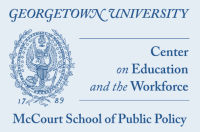Hilary Strahota
202-687-4703
hs779@georgetown.edu
As early as kindergarten, racial and ethnic factors have given equally talented Whites and Asians environmental advantages over Blacks and Latinos
(Black PR Wire)WASHINGTON--(BUSINESS WIRE)-- The great sorting of the most talented young people into haves and have-nots starts long before college, according to a new report from the Georgetown University Center on Education and the Workforce (CEW) in partnership with the Annie E. Casey Foundation. Born to Win, Schooled to Lose: Why Equally Talented Students Don’t Get Equal Chances to Be All They Can Be finds that the most talented disadvantaged youth don’t do as well as the least-talented advantaged youth. A child from a family in the highest quartile of socioeconomic status (SES) who has low test scores in kindergarten has a 71% chance of being above-median SES at age 25. However, a child from a low-SES family with high test scores has only a 31% chance of reaching above-median SES by 25.
This disparity is even more severe by race. Black (51%) and Latino (46%) tenth graders with top half math scores are more likely to earn a college degree within 10 years than their peers with bottom half math scores (23% and 22%, respectively). But, they are still less likely to earn a college degree than Whites (62%) and Asian (69%) tenth graders with top-half scores.
“To succeed in America, it’s better to be born rich than smart,” said Anthony P. Carnevale, director of CEW and lead author of the report.
People of all abilities and backgrounds stumble throughout their academic journeys. But advantaged students have safety nets to keep them on track while their less-advantaged peers do not and as a result, are more likely to fall behind and stay behind. Among children who show similar academic potential in kindergarten, the test scores of economically disadvantaged students are more likely to decline and stay low during elementary, middle, and high school than the test scores of their high-SES peers.
“The fact that children’s test scores go up and down over time shows that there is room for intervention,” said Megan L. Fasules, an assistant research professor and co-author of the report. “With smart policy changes, education can mitigate the effects of inequality.”
There is some good news. Students from low-SES families who show academic promise do have higher odds of success, particularly if they maintain high math scores in high school. If they score in the top half on math assessments in high school, 10th graders from families in the lowest quartile of SES are twice as likely to reach the top half of SES as young adults.
The bad news is that even talented poor students who make it through high school and college cannot keep pace with affluent students in the labor market, regardless of their academic success. Top-scoring kindergartners from low-SES families who earn college degrees have a 76% chance of reaching high SES by age 25 compared to a 91% chance among their low-scoring, high-SES peers who earn college degrees.
The opportunity gaps between those with higher and lower SES can be narrowed. The best chances to level the playing field lie in the education pipeline. But, to help make this a reality, policymakers must consider several options:
- Interventions in early childhood education increases the odds of success, but they are still not enough.
- Continue academic interventions throughout K–12.
- Improve and expand high school counseling so that more students have the information and social supports they need to transition from high school to postsecondary education and training.
- To ensure that talented low-SES students, who have limited exposure to education and career pathways, get the most for their education, integrate career exploration and provide access to high-quality work experience at the high school and college levels.
Other Findings:
- The highest-SES families spend almost five times as much on enrichment activities as the lowest-SES families.
- Almost all children from the highest-SES families have at least one parent with some postsecondary education, compared to less than a third of children from the lowest-SES families.
- Regardless of SES, Black kindergarteners with top-half math scores are more likely than other kindergartners to have bottom-half math scores as eighth graders.
- 10th graders from families in the lowest SES quartile are half as likely as their highest-SES peers to earn a college degree by their mid-20s—even when their test scores suggest they are equally prepared.
For the full report and a video highlighting key findings, visit cew.georgetown.edu/Schooled2Lose.
The Georgetown University Center on Education and the Workforce is an independent, nonprofit research and policy institute that studies the link between individual goals, education and training curricula, and career pathways. CEW is affiliated with the Georgetown University McCourt School of Public Policy. For more information, visit cew.georgetown.edu. Follow us on Twitter @GeorgetownCEW, Facebook, YouTube, and LinkedIn.
Note: Family SES is determined by considering household income, parents’ educational attainment, and parents’ occupational prestige (a measure of social standing, power, and earnings ability). In addition, standardized math scores are used as a measure of academic achievement since the data analyzed did not include 12th grade reading scores. However, data on reading scores indicate similar trends.
View source version on businesswire.com: https://www.businesswire.com/news/home/20190515005141/en/

